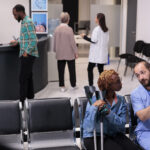Now, it’s merely a matter of day-to-day survival.
EDITOR’S NOTE: In light of the fact that hospital nurses have reported a recent dramatic increase in physical violence by patients, we asked three contributors to weigh in with their thoughts on the issue and how it can be addressed. What follows is a feature article on their input.
It was by no means the definitive anthem of the Summer of Love in 1967 – there was plenty of competition, in that regard – but the lyrics of the Beach Boys’ smash hit from that era, “Heroes and Villains,” seem downright prescient today, in retrospect.
“I’ve been in this town so long/So long to the city/I’m fit with the stuff/To ride in the rough/And sunny down snuff I’m alright/By the heroes and villains/Just see what you’ve done/Heroes and villains/Just see what you’ve done.”
Those lines recently came to mind for H. Steven Moffic, MD, one of the nation’s foremost psychiatrists and a regular contributor to Talk Ten Tuesdays and ICD10monitor, when pondering the reasons for a recent reported surge in physical and verbal abuse of frontline medical professionals.
“Over the course of the COVID-19 pandemic, healthcare workers have gone from being deemed heroes to being accused of being villains, from adulation to blame,” Moffic said. “Why has this happened, and what can be done about it?”
A Look Back
Some perspective on where things stand now can be gained by taking a look at where the healthcare industry stood just before the pandemic began, according to Moffic.
“We were burning out, and physicians at epidemic rates. That would make us even more vulnerable to any new undue stress,” he said. “What was the major cause of our burning out? Systems and administrators who were disengaging employees, putting business ethics before healthcare ethics, and setting up obstacles for us to be able to help and heal.”
Then came COVID – and the subsequent initial dearth of personal protective equipment (PPE), risk of infection and serious illness or even death, and limited available data. But amid that was messaging seen in the news media, on lawn signs, and across social media that healthcare workers weren’t just dutiful; they were heroic.
“However, as the pandemic continued, and divisiveness about what to do about social isolation, masking or not, and then the vaccination controversies came into play, and all the other changes and losses continued on, many people got more and more fearful about what was happening, their lack of control, and the uncertain risk of getting infected,” Moffic said. “Fear, as in our natural ‘fight or flight’ response, often leads to anger. I labelled the anger ‘panger’ to refer to the unique precipitant of the pandemic.”
With so much lingering uncertainty, and what Moffic described as a near-inexplicable “growing social disdain of expertise and science,” the experts found themselves becoming vilified. All this despite effects that now are approaching a staggering 50 million cases and 800,000 deaths in the U.S., milestones all but certain to be reached by year’s end.
Today, previously unthinkable protective strategies seem downright sensible.
“Preventive techniques like panic buttons and personal safety and de-escalation techniques can help,” Moffic explained. “When I worked in a medium security men’s prison, we had three basic safety processes in place: not to wear a tie, to avoid being strangled with it; sit between the patient and the door; and being able to call in nearby security by just knocking the landline phone off the hook.”
The most pressing areas of concern in the healthcare industry used to be mitigating hospital-acquired conditions, preventing readmissions, and maintaining an ever-present healthy wariness about federally contracted auditors.
Now, it’s merely a matter of day-to-day survival.
“Healthcare workers should be told that taking care of each other is the first priority to help others, just like putting on your oxygen mask first in an airplane emergency,” Moffic said. “Healthcare worker safety and high-quality care are two sides of the same coin. Whenever violence occurs, there should be ongoing monitoring and treatment available for PTSD, which is often delayed in its expression.”
There is a bitter irony in the notion that frontline medical staff generally never wanted to be either glorified or demonized.
“Healthcare workers don’t want to be either heroes or villains. Something is wrong with either image,” Moffic concluded. “We just want to be able to do our calling, to safely help take care of patients as best as we can. Only in safety can appropriate diagnosis and treatment be provided.”
An Unprecedented Issue
David M. Glaser, a shareholder in Fredrikson & Byron’s Health Law Group, longtime member of the RACmonitor editorial board, and a popular regular guest on Monitor Mondays, boasts a resume bursting with decades of rich experience and expertise.
Yet the current situation is like nothing he has ever seen.
“Medical professionals are expressing concerns I haven’t heard in nearly 30 years of doing this,” he said. “In many cases, the patient is convinced that the professional is lying to them. In addition, yelling and name-calling have gotten more acceptable. While not all yelling and name-calling leads to violence, I think most people being yelled at worry that it could, without warning, become violent. In short, even absent violence, there is worry about it.”
And that worry isn’t limited to one specialty.
“I don’t know (that) any particular group is particularly affected – everyone, from receptionists to nurses, doctors to administrators, are feeling it,” he said. “My sense is that COVID results in more yelling. And there have been enough clinic shootings that as soon as someone is yelling and making threats, the anxiety is real.”
The most high-profile example of that was when a man walked into a Minnesota clinic in February and opened fire on staff who asked how they could help him; he shot five, killing one, before also setting off a series of pipe bombs.
“I think the biggest source of anxiety is that there isn’t all that much you CAN do,” Moffic said. “It is often unclear whether terminating a patient relationship will make things better or worse. One can get an order of protection, but if someone shows up with a gun, that order isn’t terribly helpful. The loss of control is exactly what is stressing people out.”
Of course, Glaser acknowledged, “shootings are obviously rarer than threats.”
“But even knowing most threats don’t result in violence, one can’t know whether any particular threat is serious or not,” he added. “One thing we can do is make it clear threats aren’t tolerated. That could at least start to lower the number of threats from people who aren’t violent, but who feel like being aggressive may achieve something or has little cost.”
Hitting Close to Home
The notion pains Day Egusquiza, Founder and President of AR Systems, Inc. and Patient Financial Navigator Foundation, Inc., based in Idaho – a nationally recognized speaker on continuous quality improvement (CQI), benchmarking, redesigning, reimbursement systems, and implementing an operational focus of compliance both in hospitals and practices.
It boggles her mind that some healthcare workers feel as though they need to disguise themselves as a protective measure.
“Idaho has had way too much of this, including staff changing out of their scrubs before they head home to ensure that no one verbally attacks them,” she said.
One patient Egusquiza is aware of broke a door to the emergency room when he left in a rage. Others prompted medical staff to call 911, and even file harassment charges.
“Taking pictures of anyone who is doing any of these vile activities would be a good beginning,” she suggested. “Downplaying and trying to ‘not make waves’ has not worked.”
Egusquiza recalled some healthcare workers in Idaho, when asked why they didn’t report such concerns sooner, responding by noting that “no one cares, anyway.” Ironic, considering that some of the same patients creating such threats go on to “demand to be saved.”
“It is time to say, ‘no more,’ and bring the police to get involved,” she said. “It’s hard to even believe we are having this conversation. After 40+ years (in the industry) … it’s hard to even imagine this is occurring.”
Egusquiza’s concerns call to mind recent words by Dr. Ashley Carvahlo, a physician working in Idaho’s Treasure Valley who told a local television news station that when she refused to prescribe medication not federally approved for human use to treat one unvaccinated patient, a family member told her “I have a lot of ways to get people to do something, and they’re all sitting in my gun safe at home.”
According to a report by Business Insider published last week, 31 percent of hospital nurses have reported a recent increase in physical violence by patients, up from 22 percent in March 2021.
Enough is enough.













